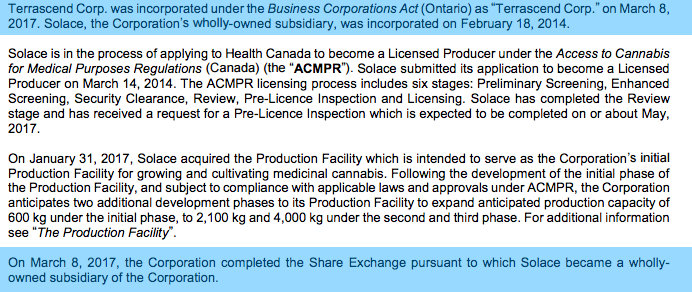Guest post by Steven Looi and Michael Miller of Initiative Capital
On February 13th, 2017, Ontario based ACMPR applicant Solace Health Inc. (Solace) filed a preliminary long form prospectus with several of Canada’s provincial security commissions with the stated intention to list their company’s shares on the Canadian Securities Exchange (CSE). On March 10th, however, Solace withdrew their application and a new company called Terrascend Corp. (Terrascend), which was newly incorporated only two days before on March 8th, filed their preliminary long form prospectus with the stated intention to list on the CSE.

The fact both companies shared the same officers and directors and filed a non-offering prospectus was no coincidence. What happened was that Solace entered into a share exchange with Terrascend with the result being that Solace was now wholly owned by Terrascend, and Solace’s previous shareholders were now owners of Terrascend. This new structure would have it so the ACMPR applicant and operating company, Solace, would no longer pursue a listing, while the newly formed holding company, Terrascend, would. This raises the question, why even bother to go through with this process and not just list the operating company?
If you were to perform a quick survey of publicly traded licensed cannabis producers in Canada, you might be surprised to find how many of them have elected to list their companies with this structure. To be specific, they all have. Supreme Pharmaceuticals (CSE: SL) (OTC: SPRWF) wholly owns licensed producer 7 ACRES, Aurora Cannabis Inc. (TSXV: ACB) (OTC: ACBFF) wholly owns licensed producer Aurora Cannabis Enterprises Inc., and THC Biomed International Ltd. (CSE: THC) (OTC: THCBF) wholly owns licensed producer THC Biomed Ltd. Even prospective producers who have yet to receive their license have trended toward this structure including Beleave Inc., (CSE: BE) (OTC: BLEVF) which wholly owns applicant corporation First Access Medical Inc. It seems to be a standard that the entire industry has adopted, so why exactly has the industry fixated on this structure?
There are a number of clear benefits and drawbacks for any entity in any industry that chooses to go public through a holding company with an operating subsidiary. In essence, in exchange for the added legal, accounting, and organizational complexities, as well as their associated costs, companies can take advantage of potential tax savings, limit potential liabilities to individual operating companies, and ease the process through which an operating company is sold off to a potential acquirer, among other benefits. In the case of Canada’s licensed cannabis producers though, the driving forces behind listing through a holding company have more to do with the restrictions placed on who can be a director or an officer of the corporation that holds the ACMPR license and what their growth plans are for the future.
Officers and directors are vital to the operation of any public corporation as the officers manage the company’s day-to-day operations while the directors effectively ‘manage the management’ on behalf of the company’s shareholders. Directors also vote on transactions to be undertaken by the company, such as mergers and acquisitions, among other critical responsibilities. To become a director of a corporation in Canada, you must be at least eighteen years of age, not declared incapable by a court, be an actual person (as opposed to a corporation), and not currently be in a state of bankruptcy[1]. If these standards do not seem particularly rigorous, its because they aren’t. Theoretically, your 19-year-old cousin with a criminal record for possession who had his car repossessed 12-months-ago and was recently discharged from bankruptcy by a court could be the director of a corporation. (Officers, whom are appointed by directors, have even more relaxed requirements.) Thankfully, shareholders get to vote on who the directors of a corporation are, so unless your cousin votes for himself within his own private corporation, he’s unlikely to get the job. When it comes to who gets to be the director or officer of a corporation that produces cannabis, however, Health Canada has a very different set of standards.
When a corporation applies for a license to produce cannabis with Health Canada, the officers and directors of that corporation are required to meet an exceptional series of qualifications well beyond those required by corporations in most other industries. The ACMPR explicitly states that “each officer and director of the corporation[2] ” must have a security clearance, and if they don’t, the minister “must refuse to issue, renew or amend a producer’s license[3].” The reasons an individual director or officer could be denied a security clearance are broad, ranging from the specific “having been involved in the diversion of a controlled substance[4] ” to the opaque “would likely create a risk to public health, safety, or security[5] . While the ACMPR has applied these stringent standards to the applicant corporation’s directors and officers, the ownership of that corporation, including holding companies with their own officers and directors, are not bound by any of these restrictions.
Recently, Maple Leaf Green World Inc. (TSXV: MGW), an applicant that chose not to list a holding company and instead listed their ACMPR applicant corporation, issued a press release on November 15th, 2016 indicating that their application was facing “additional delays” because just one of their corporate directors was a non-resident[6] of Canada. While the director resigned in response to Health Canada’s notification, the company was informed they would remain in Stage 4 of the licensing process, a stage they had been in since December 2015[7], until they had received their receipt of the required security clearance from the RCMP. While the company was able to issue a press release just two months later on January 4th, 2017, indicating they had officially advanced to Stage 5[8], the race for capital, capacity, and customers combined with Health Canada’s nebulous timelines for an applicant to go through the licensing process, can make even small delays potentially punishing for investors.
Dentons Canada LLP partner, Kris Miks, advised that “One of the primary benefits of utilizing a holding company as a vehicle for publicly traded licensed cannabis producers rather than listing the licensed producer itself is the ability to delineate those individuals who are required to obtain security clearance under the ACMPR from management and the board of directors of the listed entity. As the ACMPR requires that each officer and director of a licensed producer that is a corporation must receive a security clearance, the separation of the listed entity from the licensed producer allows the operating entity to carry on business with the minimum number of directors and officers required under the ACMPR and corporate legislation. This reduces the burden associated with obtaining security clearance from the Minster of Health, while allowing shareholders of the publicly listed vehicle to select the best possible candidates as directors and officers without concern for receipt of security clearance.”
As Canadian cannabis producers continue to grow, acquire new entities, and explore new verticals, the caliber and geography of talent needed to run these companies will inevitably change. The officers and directors that will be needed to raise capital and manage an array of cannabis businesses on a global scale will differ from those that are needed to manage a licensed production facility within Canada. Aurora, which on March 27th announced they had invested ~$6.6 million CAD for a 19.9% stake of Australian based Cann Group Limited, a licensed researcher and cultivator of medical cannabis that is set to IPO in May 2017[9], is just one example of Canada’s many cannabis players going global and diversifying their operations. The idea that shareholders would be banned from bringing on a foreign director or officer for a global company (and even if they were Canadian they would still need to be individually approved by the Minister of Health[10]) makes it easy to understand why these companies would choose to list through a holding company, a trend that is likely to continue as more producers go public.
[1] Government of Canada, Directors and Officers, https://www.ic.gc.ca/eic/site/cd-dgc.nsf/eng/cs06643.html Accessed April 1st, 2017.
[2] Access to Cannabis for Medical Purposes Regulations, Clause 34
[3] Ibid, Clause 36
[4] Ibid.
[5] Ibid.
[6] Maple Leaf Green World Inc. Corporate Update. November 15th, 2016.
[7] Ibid.
[8] Maple Leaf Green World Inc. Corporate Update. January 4th, 2017.
[9] http://www.newswire.ca/news-releases/aurora-cannabis-to-be-cornerstone-investor-in-australian-medical-cannabis-ipo-617278563.html Accessed April 5th, 2017.
[10] Access to Canada for Medical Purposes Regulations, Clause 40.

About the authors:
Michael Miller and Steven Looi are founding members of Initiative Capital, a cannabis venture fund based in Toronto, Canada.
Michael is a multi-disciplinary venture capitalist and a regular adviser to early-stage companies looking for guidance on valuation, raising capital, and long-term positioning. A frequent writer on the emerging cannabis industry, Michael’s writings can be found in leading trade and consumer publications.
Prior to co-founding Initiative Capital, Steven was an entrepreneur with international reach having launched and successfully exited from businesses in both China and Canada. With experience founding, operating, and managing software, pharma, and urban agricultural companies, Steven brings a multifaceted approach to the challenges of the cannabis industry. Steven has been a regular fixture at industry events in both Canada and the United States in his capacity as a cannabis angel for emerging companies.

